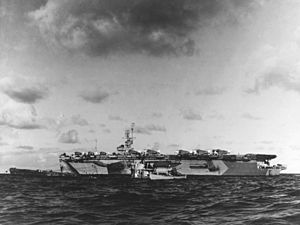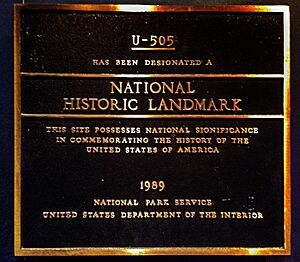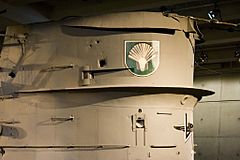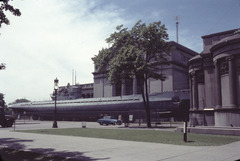German submarine U-505 facts for kids
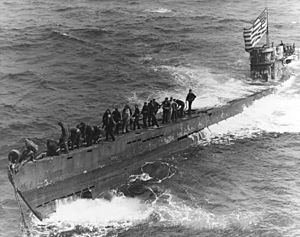
U-505 shortly after being captured, pictured from the USS Pillsbury in preparation for towing
|
|
Quick facts for kids History |
|
|---|---|
| Name | U-505 |
| Ordered | 25 September 1939 |
| Builder | Deutsche Werft AG, Hamburg-Finkenwerder |
| Yard number | 295 |
| Laid down | 12 June 1940 |
| Launched | 24 May 1941 |
| Commissioned | 26 August 1941 |
| Fate | Captured by US Navy on 4 June 1944 |
| Status | Preserved as a museum ship |
| General characteristics | |
| Type | Type IXC submarine |
| Displacement | |
| Length |
|
| Beam |
|
| Height | 9.60 m (31 ft 6 in) |
| Draught | 4.70 m (15 ft 5 in) |
| Installed power |
|
| Propulsion |
|
| Speed |
|
| Range |
|
| Test depth | 230 m (750 ft) |
| Complement | 48 to 56 |
| Armament |
|
| Service record | |
| Part of: |
|
| Identification codes: | M 46 074 |
| Commanders: |
|
| Operations: |
|
| Victories: | 8 merchant ships sunk (45,005 GRT) |
|
U-505 (IXC U-boat)
|
|
| Built | 1941 |
| Architect | Deutsche Werft AG, Hamburg, Germany |
| NRHP reference No. | 89001231 |
| Significant dates | |
| Added to NRHP | 1989 |
| Designated NHL | 1989 |
The U-505 was a German Type IXC submarine used during World War II. It was captured by the United States Navy on June 4, 1944. Today, it is a museum ship in Chicago, where people can visit and learn about its history.
This submarine had a challenging career. It was known as the "most heavily damaged U-boat to successfully return to port" during World War II. It went on six patrols that didn't go well. On June 4, 1944, the U-505 was captured by a special group of ships from the United States Navy. This was one of only six U-boats captured at sea by Allied forces during the war. Almost all of the U-505's crew were saved by the Navy ships.
The submarine was secretly towed to Bermuda. Its crew was held as prisoners of war in a secret camp in America, kept separate from other prisoners. The Navy kept the capture a big secret. They worked hard to make sure Germany didn't find out.
In 1954, the U-505 was given to the Museum of Science and Industry in Chicago, Illinois. It is now one of only four German World War II submarines still around today as museum ships. It is also one of just two Type IXC submarines that still exist.
Contents
Submarine Design and Features
German Type IXC submarines were a bit bigger than the earlier Type IXB models. The U-505 weighed about 1,120 tonnes (1,100 long tons) when it was on the surface. It weighed 1,232 tonnes (1,213 long tons) when it was underwater.
The submarine was 76.76 m (251 ft 10 in) long overall. Its strong inner hull, called the pressure hull, was 58.75 m (192 ft 9 in) long. The submarine was 6.76 m (22 ft 2 in) wide and 9.60 m (31 ft 6 in) tall. It sat 4.70 m (15 ft 5 in) deep in the water.
The U-505 used two powerful diesel engines when on the surface. These engines produced a total of 4,400 PS (3,240 kW; 4,340 shp) of power. When underwater, it used two electric motors that produced 1,000 shp (1,010 PS; 750 kW; 1,000 shp) of power. It had two shafts and two 1.92 m (6 ft) propellers to move it through the water. This submarine could dive to depths of 230 m (750 ft).
The U-505 could travel at a top speed of 18.3 knots (33.9 km/h; 21.1 mph) on the surface. Underwater, its top speed was 7.3 kn (13.5 km/h; 8.4 mph). When submerged, it could travel 63 nautical miles (117 km; 72 mi) at 4 kn (7.4 km/h; 4.6 mph). On the surface, it could go 13,450 nmi (24,910 km; 15,480 mi) at 10 kn (19 km/h; 12 mph).
The submarine was armed with six 53.3 cm (21 in) torpedo tubes. Four were at the front and two at the back. It carried 22 torpedoes. It also had one 10.5 cm (4.13 in) naval gun with 180 rounds. For defense against aircraft, it had a 3.7 cm (1.5 in) gun and a twin 20 mm (0.79 in) antiaircraft gun. The crew, or complement, for the U-505 was 48 sailors.
Early Service History
The U-505 was built by Deutsche Werft in Hamburg, Germany. Its construction started on June 12, 1940. It was launched on May 24, 1941. The submarine officially joined the German Navy on August 26, 1941. Its first commander was Kapitänleutnant Axel-Olaf Loewe. Later commanders included Kptlt. Peter Zschech and Oblt.z.S. Harald Lange.
The U-505 went on twelve patrols during the war. It sank eight ships, which together weighed over 45,005 GRT. These ships included three American, two British, one Norwegian, one Dutch, and one Colombian vessel.
First Patrol: Training and Travel
The U-505 was part of the 4th U-boat Flotilla for training. Then, on February 1, 1942, it joined the 2nd U-boat Flotilla for active duty. Its first patrol began on January 19, sailing from Kiel, Germany. For 16 days, it sailed around the British Isles. It then docked at Lorient in occupied France on February 3. During this patrol, it didn't fight any enemy ships and wasn't attacked.
Second Patrol: First Victories
The U-505 left Lorient on February 11, 1942, for its second patrol. Over 86 days, it traveled to the west coast of Africa. There, it sank its first ships. In less than a month, the U-505 sank four ships. These were the British Benmohr, the Norwegian Sydhav, the American West Irmo, and the Dutch Alphacca. These ships totaled over 25,041 GRT. On April 18, an Allied aircraft attacked the U-505 in the mid-Atlantic. The submarine was only slightly damaged.
Third Patrol: Caribbean Operations
The U-505 started its third patrol on June 7, 1942, from Lorient. It sank two American ships, Sea Thrush and Thomas McKean. It also sank the Colombian ship Urious in the Caribbean Sea. The Urious was a sailing ship owned by a Colombian diplomat. Its sinking was one of several events that led Colombia to declare war on Germany later. The U-505 returned to Lorient on August 25 after 80 days at sea, without being attacked.
Fourth Patrol: A Close Call
The U-505's fourth patrol took it to the northern coast of South America. It left Lorient on October 4, 1942. On November 7, it sank the British ship Ocean Justice off the coast of Venezuela. Three days later, near Trinidad, a Lockheed Hudson maritime patrol aircraft from the Royal Air Force surprised the U-505 on the surface. The plane dropped a 250 lb (110 kg) bomb directly onto the submarine's deck.
The explosion killed one officer and wounded another in the conning tower. It also ripped off the antiaircraft gun and badly damaged the submarine's strong outer hull. The aircraft was hit by pieces from the bomb and crashed into the ocean, killing its crew. The U-505's pumps stopped working, and water flooded the engine room. Commander Zschech ordered the crew to leave the ship. However, the technical crew, led by Chief Petty Officer Otto Fricke, insisted on trying to save it. They managed to seal the leaks after almost two weeks of repairs. The U-505 then slowly made its way back to Lorient.
Challenging Patrols and Low Morale
After six months of repairs in Lorient, the U-505 began its fifth patrol on July 1, 1943. It returned after only 13 days. Three British destroyers had chased it for over 30 hours. The U-505 wasn't badly damaged, but it needed more repairs in France.
The next four patrols for the U-505 were all cut short after just a few days. This was due to equipment problems and even sabotage by French dockworkers who were secretly helping the Resistance. Workers deliberately drilled a hole in a diesel fuel tank and caused problems with electrical and radar equipment. This happened so often that the U-505 became a joke at the Lorient base. After one failed patrol, a sign appeared in the docking area that read: "U-505's Hunting Ground."
Tenth Patrol and a Commander's Struggle
After ten months in Lorient, the U-505 set out for its tenth Atlantic patrol. It hoped to change its bad luck. On October 24, 1943, British destroyers found it east of the Azores. The submarine was forced to dive and faced a severe depth-charge attack. Under intense pressure during this attack, Commander Zschech was no longer able to lead, and the first officer, Paul Meyer, took command. Meyer managed to return the submarine to port with only minor damage. The German Navy cleared Meyer of any blame for the incident.
Eleventh Patrol: A Rescue Mission
The U-505 was then commanded by Oblt.z.S. Harald Lange. Its 11th patrol started on Christmas Day 1943. It returned early to Lorient on January 2, 1944. This was because it had rescued 33 crew members from the German torpedo boat T25. That ship had been sunk by British cruisers in the Bay of Biscay a few days earlier.
The Capture of U-505
Allied Hunter-Killer Group
The Allies knew from secret German messages that U-boats were operating near Cape Verde. However, they didn't know exactly where. The US Navy sent Task Group 22.3, a special hunter-killer group, to the area. This group was led by Captain Daniel V. Gallery. It included the escort aircraft carrier Guadalcanal and five destroyer escorts. The group left Norfolk, Virginia, on May 15, 1944. They began searching for U-boats in late May using special radio equipment and planes.
Finding and Attacking the Submarine
On June 4, 1944, at 11:09 AM, Task Group 22.3 found the U-505 using sonar (ASDIC). The submarine was about 150 nmi (280 km; 170 mi) off the coast of Río de Oro. It was only 800 yards (700 m) from the ship Chatelain. The escort ships immediately moved towards the U-boat. The Guadalcanal sped away and launched a fighter plane to join others already in the air.
The Chatelain was so close to the U-505 that regular depth charges would not sink fast enough. So, it fired Hedgehog antisubmarine mortars. After passing the submarine, the Chatelain turned to drop depth charges. One of the aircraft spotted the U-505 and fired into the water to mark its position. The Chatelain then dropped its depth charges. Right after the explosions, a large oil slick appeared on the water. The fighter pilot radioed: "You struck oil! Sub is surfacing!" Less than seven minutes after the attack began, the badly damaged submarine surfaced less than 600 m (700 yd) away. The Chatelain immediately opened fire with all its weapons. Other ships and the two fighter planes also joined the attack.
Commander Lange believed the U-505 was too damaged. He ordered his crew to abandon ship. They quickly left the submarine. They tried to sink it by opening some valves, but they left the engines running. The rudder was damaged, so the submarine began circling clockwise at about 7 kn (13 km/h; 8.1 mph). The commander of the Chatelain thought the U-boat was attacking his ship. He ordered a torpedo to be fired, but it missed the abandoned U-505.
Saving the Submarine
Captain Gallery really wanted to capture a U-boat. He had encouraged his captains to prepare for such a chance. The Chatelain and Jenks picked up the German survivors. Meanwhile, a team of eight men from the Pillsbury, led by Lt. Albert David, boarded the submarine. They entered through the conning tower. They found the body of Signalman First Class Gottfried Fischer, the only person who died in the fight. The U-505 was empty.
The boarding party quickly grabbed charts and codebooks. They closed the valves that were letting in water and stopped the engines. The submarine was low in the water and sinking at the back. A German crewman, Ewald Felix, later helped explain how the scuttling attempt failed.
The Pillsbury tried to tow the submarine, but it kept bumping into it. The Pillsbury had to move away with three of its sections flooded. A second team from the Guadalcanal then attached a towline from the aircraft carrier to the U-boat. The Guadalcanal's chief engineer, Commander Earl Trosino, joined the salvage team. He disconnected the submarine's diesel engines from its electric motors. He left the electric motors connected to the propellers. As the Guadalcanal towed the U-boat, the propellers spun in the water. This made the electric motors act like generators, charging the batteries. With power from the batteries, the U-505's pumps cleared out the water. Its air compressors blew air into the ballast tanks, making it float properly on the surface.
The capture happened near French Morocco, which was controlled by the Allies. However, Casablanca was known to have German spies. So, a different safe port was needed for the submarine. After three days of towing, the Guadalcanal handed the U-505 over to the fleet tug Abnaki. On June 19, the submarine arrived at the Great Sound in Bermuda. It had been towed for 1,700 nautical miles (3,150 km; 1,960 mi).
The US Navy took 58 prisoners from the U-505, three of whom were wounded. The crew was held in great secrecy at Camp Ruston in Ruston, Louisiana. Keeping the capture a secret was very important. The submarine's flag was kept personally by the Commander in Chief of the Atlantic Fleet during the war. The submarine's crew members were kept separate from other prisoners of war. The Red Cross was not allowed to see them. The German Navy eventually declared the crew dead and told their families. The crew was not returned home until 1947.
Awards for the Capture
Historian Clay Blair said that Admiral Ernest King, the US Chief of Naval Operations, was very angry with Captain Gallery. He worried that capturing the U-boat might put Ultra at risk. Ultra was the secret intelligence gained from decoding German messages. If Germany found out a U-boat had been captured, they might change their secret codes. This could have stopped the Allies from getting vital information right before the Normandy landings. Because of this, the usual practice was to sink U-boats rather than try to capture them. However, "cooler heads prevailed," and no one was punished.
Lieutenant Albert David received the Medal of Honor for leading the team that boarded the submarine. This was the only time this award was given to an Atlantic Fleet sailor in World War II. Torpedoman's Mate Third Class Arthur W. Knispel and Radioman Second Class Stanley E. Wdowiak were the first two to follow David into the submarine. They received the Navy Cross. Seaman First Class Earnest James Beaver received the Silver Star. Commander Trosino received the Legion of Merit. Captain Gallery, who planned and carried out the operation, received the Navy Distinguished Service Medal. The entire Task Group received the Presidential Unit Citation. Admiral Royal E. Ingersoll, Commander in Chief, US Atlantic Fleet, praised the group for their "outstanding performance" and called it "a feat unprecedented in naval history."
The U-505's Final Journey

The US Navy kept the U-505 at its base in Bermuda. Navy intelligence officers and engineers studied it closely. To keep the secret that it had been captured, the submarine was painted to look like a US submarine and renamed USS Nemo.
After the war in Europe ended, the U-505 was used to help sell E War Bonds. People who bought a bond could also buy a ticket to go inside and explore the submarine. In June 1945, it visited New York City, Philadelphia, and Baltimore. Captain Gallery was there for the opening of the exhibit in Washington, D.C.
After the war, the Navy didn't need the U-505 anymore. Experts had already examined it in Bermuda. It was left unused at the Portsmouth Navy Yard. The Navy decided to use it as a target for gunnery and torpedo practice until it sank. In 1946, Rear Admiral Gallery, who didn't want the U-505 to be destroyed, told his brother, Father John Gallery, about the plan. Father John contacted President Lenox Lohr of the Museum of Science and Industry to see if they would be interested in it. The museum already wanted to display a submarine, so getting the U-505 seemed perfect.
The US government gave the submarine to the museum in September 1954. People in Chicago raised $250,000 to move and install the submarine. Coast Guard tugboats and cutters towed the U-boat through the Great Lakes. It made a stop in Detroit, Michigan, in July 1954. The museum officially opened the exhibit on September 25, 1954. It serves as a war memorial to all the sailors who died in the first and second Atlantic campaigns.
A Museum Ship Today
By the time the U-505 arrived at the museum, almost all its removable parts had been taken from its inside. It wasn't in good shape to be an exhibit. So, museum director Lohr asked the German companies that made the original parts for replacements. Admiral Gallery wrote in his book Eight Bells and All's Well that every company sent the requested parts for free. Most of them included letters saying they wanted the U-505 to show off German technology.
In 1964, 20 years after the submarine's capture, a reunion was held at the museum. Captain Gallery returned some binoculars from the ship to Commander Lange, who had owned them.
The Navy had removed the periscope and put it in a water tank for research. It was at the Arctic Submarine Laboratory in Point Loma, California, and was forgotten there. Before the lab was torn down in 2003, the periscope was saved. The Navy then gave it to the museum to be displayed with the submarine.
By 2004, the U-boat's outside had been damaged by the weather. So, in April 2004, the museum moved it to a new, climate-controlled underground location next to the museum. They restored it and reopened it to the public on June 5, 2005. In 2019, the museum updated the submarine again. They made it look even more like it did originally. A special exhibit with many more items from the submarine also opened in the museum's main area.
- U-505 at the Museum of Science and Industry
Ships Sunk by U-505
| Date | Ship Name | Nationality | Tonnage (GRT) |
Fate |
|---|---|---|---|---|
| 5 March 1942 | Benmohr | 5,920 | Sunk | |
| 6 March 1942 | Sydhav | 7,587 | Sunk | |
| 3 April 1942 | West Irmo | 5,775 | Sunk | |
| 4 April 1942 | Alphacca | 5,759 | Sunk | |
| 28 June 1942 | Sea Thrush | 5,447 | Sunk | |
| 29 June 1942 | Thomas McKean | 7,191 | Sunk | |
| 22 July 1942 | Urious | 153 | Sunk | |
| 7 November 1942 | Ocean Justice | 7,173 | Sunk |
More About Submarines
Captured German U-boats from World War II
- German submarine U-110 (1940)
- German submarine U-570, later HMS Graph
- German submarine U-559
- German submarine U-744
- German submarine U-1024
German U-boats Still Existing Today
- SM U-1
- German submarine U-534
- German submarine U-995
- German submarine U-2540
Other Related Topics
- List of submarine museums
- U-571
See also
 In Spanish: U 505 (1941) para niños
In Spanish: U 505 (1941) para niños



